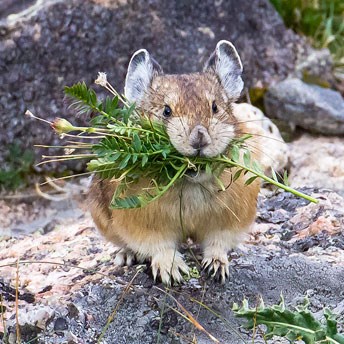
NPS/Ann Schonlau The pika (Ochotona princeps) is an indicator species for the potential effects of climate change. Pikas are abundant in Rocky Mountain National Park, but concerns exist that their sensitivity to summer heat and particularly the lack of snowfall for insulation in the winter may result in declining numbers. Although pikas are not currently threatened or endangered, they are being monitored to ascertain changes in their locations in the park. 
NPS Number in Rocky Mountain National ParkPikas are abundant in the park at elevations generally above treeline. Rocky Mountain National Park is unique in that two different subspecies — northern and southern — meet in this park and interbreed in some areas. Hotter temperatures at lower elevations curtail the movement of pikas between populations and reduce the opportunity for genetic mixing. Where to SeePikas live in and around talus slopes and in mountain meadows. Pikas may be found in areas on the tundra such as Rainbow Curve, Rock Cut, and Tundra Communities Trail. They are frequently seen along the trail to Lake Helene, near Timberline Falls, and after the Emerald Lake Overlook on the Flattop Mountain Trail.

NPS/Ann Schonlau 
NPS/Jim Ecklund Habitat
Management Concerns
ResearchPikas at Rocky Mountain National Park have been studied extensively as part of the National Park Service's multi-park Pikas in Peril project, a study focusing on the long-term survival of this species in a changing climate. Today, park pikas are monitored in collaboration with the Front Range Pika Project, a citizen-science effort coordinated by researchers at the Denver Zoo, Rocky Mountain Wild, and the University of Colorado-Boulder. Citizen scientists visit areas with appropriate habitat to look for pika, or signs of pika, to help us better understand the distribution of pikas throughout the park. More information on the Front Range Pika Project can be found here: www.pikapartners.org/ |
Last updated: July 5, 2022
